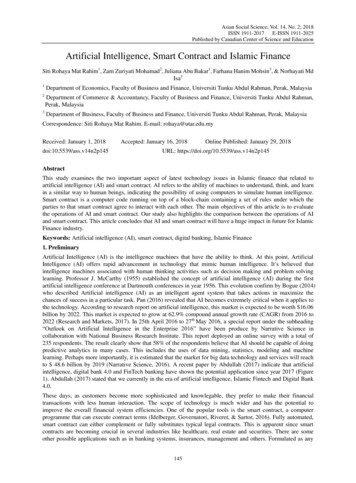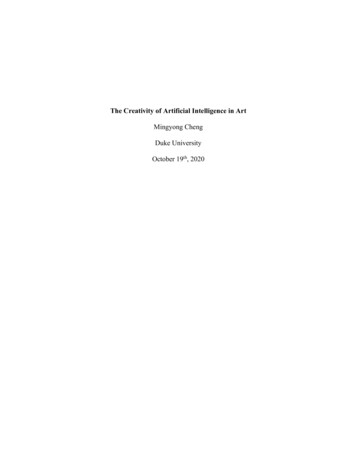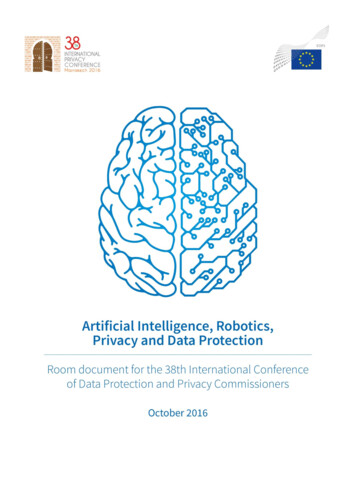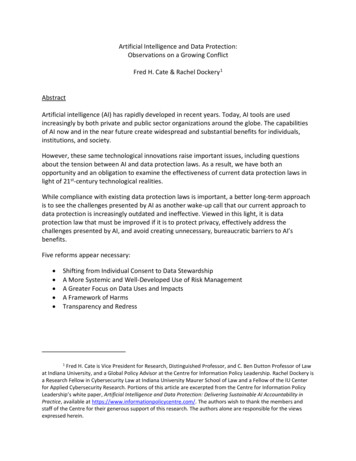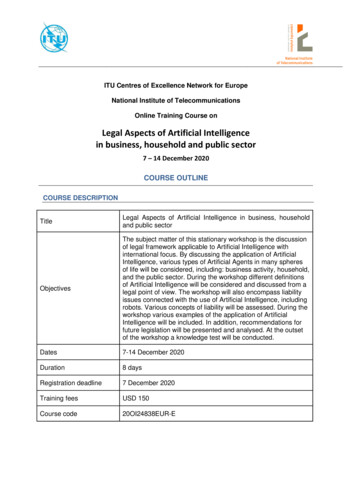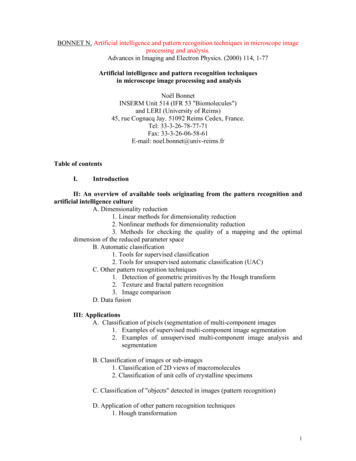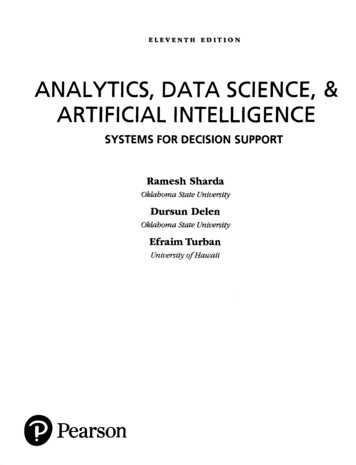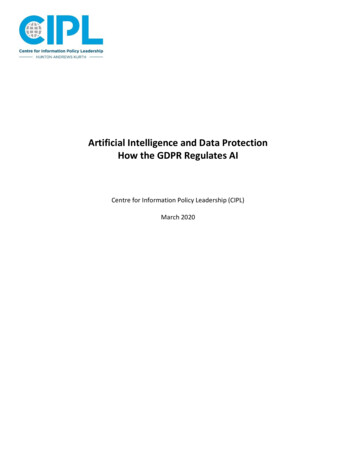
Transcription
Artificial Intelligence and Data ProtectionHow the GDPR Regulates AICentre for Information Policy Leadership (CIPL)March 2020
ContentsI.Introduction . 3II.How GDPR Applies Generally in the Context of AI. 4A.Legal Basis . 5B.Data Protection Principles . 5C.Accountability . 6D.Appointing a Data Protection Officer. 7E.Article 30 Inventory. 8F.Controller-Processor Contracts and Data Transfers . 8G.Data Breaches . 9H.Individual Rights . 9I.Data Protection by Design and by Default . 9J.Extraterritorial Effect of the GDPR . 10K.Data Protection Authorities, Sanctions and Enforcement . 10III.GDPR Provisions of Particular Relevance to AI . 12A.Fair Processing . 12B.Data Minimisation. 13C.Data Protection Impact Assessments (DPIAs). 14IV.GDPR Provisions that Specifically Regulate AI . 15A.Automated Decision-Making – Definition and Scope . 15B.Automated Decision-Making – Transparency and Logic Involved . 16C.Automated Decision-Making – Human Intervention and Right to Contest . 17V.High-Level Expert Group Guidelines . 17VI.Conclusion . 192
Artificial Intelligence and Data Protection – How the GDPR Regulates AIThis paper forms a part of the Centre for Information Policy Leadership’s (CIPL)1 special EU Project onAccountable AI. The project aims to facilitate expert dialogue and engagement between EU policymakers and businesses, leaders in AI use and development. The paper was written in collaboration withOlivia Lee, Associate at Hunton Andrews Kurth LLPI.INTRODUCTIONOn 19 February 2020 the European Commission published a “White Paper on Artificial Intelligence: aEuropean approach to excellence and trust”2 (the White Paper). This followed Ursula von der Leyen’sannouncement that as president of the European Commission she intended to put forward legislation fora coordinated European approach on the human and ethical implications of artificial intelligence (AI)within her first 100 days in office (which commenced on 1 December 2019). The White Paper is open forconsultation until 19 May 2020.The European Commission, in its 2018 Communication on Artificial Intelligence, defined AI as “systemsthat display intelligent behaviour by analysing their environment and taking actions—with some degreeof autonomy—to achieve specific goals.”3 This is just one of a number of descriptions of this increasinglyused technology, which includes computer systems that perform tasks involving visual perception, speechrecognition, decision-making and translation between languages.4 AI capabilities are advancing rapidly.However, in order to harness AI’s full potential, the legal concerns often raised regarding its use ofpersonal data (i.e. information relating to an identified or identifiable individual) and the potential biasand unpredictability in its output need to be confronted.The General Data Protection Regulation (EU) 2016/679 (GDPR) does not refer to AI specifically, but ratherregulates the processing of personal data regardless of the technology used. As a consequence, anytechnology that is designed to process personal data, including AI, is fully captured by the regime. Thisincludes many of the requirements for trustworthy AI as highlighted by the High-Level Expert Group on AI(HLEG), a group of 52 experts appointed by the EU Commission to support the implementation of its AIstrategy.5 The European Data Protection Board (EDPB) commented in a recent letter to a Member of the1CIPL is a global data privacy and cybersecurity think tank in the law firm of Hunton Andrews Kurth LLP and isfinancially supported by the law firm and 90 member companies that are leaders in key sectors of the globaleconomy. CIPL’s mission is to engage in thought leadership and develop best practices that ensure both effectiveprivacy protections and the responsible use of personal information in the modern information age. CIPL’s workfacilitates constructive engagement between business leaders, privacy and security professionals, regulators andpolicymakers around the world. For more information, please see CIPL’s website. Nothing in this note should beconstrued as representing the views of any individual CIPL member company or of the law firm of Hunton AndrewsKurth. This note has been prepared for informational purposes only and should not be construed as legal advice.2White Paper on Artificial Intelligence: a European approach to excellence and trust.3Communication: Artificial Intelligence for Europe.4English Oxford Living Dictionaries, “Artificial Intelligence”, available athttps://www.lexico.com/definition/artificial intelligence.5HLEG: “Ethics Guidelines for Trustworthy AI.”3
European Parliament: “the GDPR is built in a technologically neutral manner in order to be able to faceany technological change or revolution.”6In addition, there are also GDPR provisions that specifically allude to technologies or methods ofprocessing that incorporate aspects of AI. These include the GDPR’s provisions on automated decisionmaking. Finally, there are provisions of the GDPR that specifically address some of the common issues andrisks associated with AI, such as those relating to the data protection principle of data minimisation andthe requirement that personal data be processed lawfully and fairly. Myriad guidance has been publishedto date on the topic of how AI works within the context of data protection legislation, including by dataprotection authorities (DPAs)7 and by the HLEG.8Below we examine how the GDPR already regulates AI systems. In Section II we detail how the GDPRapplies generally to AI systems in the same manner as any other processing of personal data. In SectionIII we highlight the GDPR provisions of particular relevance in the context of AI, and how these provisionsgovern and limit its use. In Section IV we discuss the provisions of the GDPR that specifically regulate AI.Finally, in Section V we look at how the principles for trustworthy AI outlined by the HLEG overlap withthe GDPR requirements.II.HOW GDPR APPLIES GENERALLY IN THE CONTEXT OF AIAs stated by the EDPB, “[a]ny processing of personal data through an algorithm falls within the scope ofthe GDPR”.9 Therefore, whenever an AI system uses personal data, all of the standard provisions of theGDPR may apply. Where personal data is processed by an AI system, this is carried out in two distinctphases—the algorithmic training phase and the use phase. During the former the AI’s algorithm is trainedon a set of data, allowing it to create a model by identifying patterns and connections between differentdata points. In the latter phase, this model is applied to the particular use case that the AI was designedfor, in order to provide a prediction or classification, assist a human decision or make a decision itself.Personal data is therefore a vital component for the full life cycle of an AI system.It should be noted that not all AI systems process personal data. But even where AI systems are notdesigned to process personal data, instead relying on anonymised data,10 the line between personal dataand non-personal data is increasingly becoming blurred. This may stem from a lack of robustness inanonymisation techniques and the risk of re-identification stemming from the correlations and inferencesthat can be pulled from aggregated data sets. When it comes to AI in particular, the unforeseenconsequences of using a system designed to make connections and spot patterns not immediately visibleto the human eye increases this risk of re-identification.6EDPB Response to the MEP Sophie in‘t Veld’s letter on unfair algorithms.CNIL: “How Can Humans Keep the Upper Hand? The ethical matters raised by algorithms and artificialintelligence”; AP: “Toezicht op AI & Algoritmes”; ICO: “Big Data, AI, Machine Learning and Data Protection”; AEPD:“Una aproximación para la adecuación al RGPD de tratamientos que incorporan Inteligencia Artificial”;Datatilsynet: “Artificial Intelligence and Privacy”.8See note 5.9EDPB Response to the MEP Sophie in‘t Veld’s letter on unfair algorithms.10It should be noted that as per recital 26 and Article 4(5) GDPR, pseudonymised data – which is data no longerattributable to an individual without the use of additional information - is still considered to be personal data,hence subject to the GDPR.74
A. Legal BasisFor all processing of personal data using AI systems, controllers11 need to rely on one of the six legal basesfor processing set out under Article 6(1) of the GDPR. Most commonly controllers rely on consent,legitimate interests, legal obligation or contractual necessity.12 An appropriate legal basis should beestablished during both the training phase and the use phase.There are various requirements associated with these legal bases. For example, for consent to be validunder the GDPR, it must be specific, informed, freely given and unambiguous.13 With respect to thelegitimate interest legal basis, controllers are required to balance the interests they (or third parties) arepursuing and the interests and rights of the individuals whose personal data is being processed. In the AIcontext, this may mean defining the objective of the AI’s processing at the outset and making sure theoriginal purpose of the processing is re-evaluated if the AI system provides an unexpected result, eitherso that the legitimate interests pursued can be identified or so that valid consent, as the case may be, canbe collected from individuals.The GDPR sets a general prohibition on processing special categories of data, such as data relating tohealth, race or sexual orientation, except in specific circumstances, such as where the individual hasprovided explicit consent.14 Any use of AI to process such data, which is likely to be undertaken whereverAI is used in, for example, the health sector or in relation to crime prevention and detection, needs to relyon one of the specific derogations set out under Article 9 to this general prohibition.The processing of personal data of children also warrants particular care under the GDPR. For example,where an information society service is offered to a child (i.e. someone under the age of 16) and his/herconsent is obtained, that consent must be provided or authorised by an adult with parental responsibilityfor that child (though Member States are permitted to lower this age to 13).15 Controllers need to be morecautious when developing or using AI systems designed to offer such services to children.B. Data Protection PrinciplesArticle 5(1) of the GDPR sets out data protection principles that must be complied with under the GDPR.Some of these are of particular relevance to AI systems (see Section III), but all processing also need to11In the context of AI there is some complexity in identifying which party acts as the “controller” for the purposesof the GDPR. Depending on the nature of the AI system, the purposes for which it is used, the stage at which it isused and the level of control each party has, the controller may be the designer of the system, the developer thattrains it, the entity selling it or the entity using it.12There may also be instances where AI is deployed in the public interest to protect the vital interests ofindividuals. The ICO states in its guidance that it may be difficult to prove that the use of technology such as bigdata analytics is “strictly necessary” in a contractual context.13The ICO has suggested, as a way of meeting this standard, that it is possible to approach consent in a moregranular fashion than regarding it as a yes/no binary choice. When it comes to AI in particular, it will be necessaryto take a more flexible approach, where individuals provide consent to different forms of processing at differentstages of a system’s use of their data, as opposed to being provided only with a binary choice at the outset.14Article 9 GDPR.15Article 8(1) GDPR.5
comply with the principles of purpose limitation, accuracy, storage limitation, and integrity andconfidentiality (security).The purpose limitation principle requires that controllers using AI systems determine the purpose of theAI system’s use at the outset of its training or deployment, and perform a re-assessment of thisdetermination should the system’s processing throw up unexpected results, since it requires that personaldata only be collected for “specified, explicit and legitimate purposes” and not used in a way that isincompatible with the original purpose.16 In the same vein, the storage limitation principle requires thatpersonal data be kept in identifiable form for no longer than is necessary for the purposes for which thedata is processed.17The accuracy principle requires that personal data is accurate and kept up-to-date.18 This principle is ofparticular importance for fully automated systems, where the output could have a significant impact onindividuals with little human oversight. Feeding an AI system inaccurate data could lower the quality ofthe output, and this principle requires that AI users take a particularly vigilant approach to ensuring thatthe data set is not diluted by bad quality data.19 This emphasis on the accuracy of data is highlighted bythe EDPB in its draft Guidelines on Privacy by Design and by Default,20 where it provides the example of abank using AI to determine which customers are granted a loan. In an instance like this, where anindividual may be relying on the decision that the algorithm makes, inaccurate data resulting in animprecise decision could have a significant impact on individuals.Finally, the principle that personal data should be processed securely21 requires that those developing,deploying or using AI consider the particular security risk issues that such use may raise and mitigate thoseissues promptly. In addition to potential unauthorised access to personal data, a lack of proper securitymay lead to unauthorised third parties’ accessing and tampering with the algorithm to change its logicand outcomes. This may have serious consequences for individuals where, for example, a decision is maderegarding them by or with the help of this algorithm.C. AccountabilityAccountability requires those processing personal data to put in place comprehensive organisationalpolicies and procedures to ensure that personal data is processed in compliance with the GDPR’srequirements and to be able to demonstrate those policies and procedures.22 In the context of AI,controllers need to be accountable to both regulators and individuals, and need to take into account the16Article 5(1)(b) GDPR.Article 5(1)(e) GDPR.18Article 5(1)(d) GDPR.19It has been commented by the CNIL in its report: “the temptation for negligence in this regard must be takenseriously. Especially in some areas where the impact of poor quality data might not be immediately perceptible,such as human resources and recruitment”.20Guidelines 4/2019 on Article 25 Data Protection by Design and by Default (version for public consultation).21Article 5(1)(f) GDPR.22Article 24 GDPR. The EDPB also stresses that “While Art. 24 GDPR primarily concerns the rights to dataprotection and privacy, it may also involve other fundamental rights such as freedom of speech, freedom ofthought, freedom of movement, prohibition of discrimination, and the rights to liberty, conscience and religion.”EDPB Response to the MEP Sophie in‘t Veld’s letter on unfair algorithms.176
likelihood and severity of the consequences of the AI’s use on individuals. They cannot simply deploy anAI system and then blame that system when its output harms individuals or results in non-compliance.Controllers are subject to more onerous accountability obligations than processors. In the context of AI,parties that would typically act as processors, such as software developers or system designers, may beacting as co-controllers (where each party decides the purposes and means of their own processing of thepersonal data used by the AI) or as joint controllers (e.g. where the parties develop an AI systemtogether).23 In these instances, each party needs to comply with the controllership obligations under theGDPR in relation to the AI system.An organisation’s accountability program needs to comprise several elements, as set out by CIPL’saccountability wheel in its White Paper on Organisational Accountability - Past, Present and Future.24 Inthe context of AI, an organisation’s privacy management program includes: leadership and oversight(ensuring oversight and buy-in from top-level management on the need to develop, deploy or use AIresponsibly); risk assessment (assessing the impact of the AI system on individuals to mitigate potentialrisks); the creation and implementation of appropriate policies and procedures (creating operational,verifiable and auditable controls); transparency (providing understanding, explainability, traceability andinformation on the benefits of the AI system and rights of individuals); training and awareness (ensuringthat the relevant employees understand their responsibilities with respect to the development or use ofa particular AI system); control and monitoring (verifying and auditing practices to uncover potential noncompliant situations related to the use of AI and to address them); and response and enforcement(responding to data breaches, individual complaints or inquiries from regulators).With regard to the requirements for leadership and oversight, implementation of policies and proceduresand response and enforcement, the French DPA (the CNIL) has commented that: “the roll-out of analgorithmic system systematically must give rise to a clear attribution of the liabilities that should beassumed in its operation”. The CNIL recommends identifying a specific team or authority within acompany that is responsible for the use of AI systems wherever personal data is processed, so that thisteam can be reached easily by individuals.25D. Appointing a Data Protection OfficerControllers and processors must designate a data protection officer (DPO) where one of the followingcriteria applies:26 (i) processing is carried out by a public authority or body;27 (ii) their core activities consist23The EJC has taken a broad approach to this classification—for example a party may be a joint controller evenwhere it does not have access to any personal data processed by the system. The parties also do not need to shareequal responsibility for the processing to be considered joint controllers. Case C-40/17 Fashion ID GmbH & Co. KG vVerbraucherzentrale NRW eV, [2020] 1 C.M.L.R. 16.24CIPL report: “CIPL White Paper on Organisational Accountability - Past, Present and Future.”25CNIL: “How Can Humans Keep the Upper Hand? The ethical matters raised by algorithms and artificialintelligence.”26Article 37 GDPR.27For example processing in the context of a government department.7
of processing activities involving regular and systematic monitoring of individuals on a large scale;28 or (iii)their core activities consist of processing on a large scale of special categories of data.29In the context of an AI system, there is a higher likelihood that one of these triggers is present than withother forms of processing. For example AI is used in the context of medical diagnoses (which will includesensitive personal data), and by its nature AI requires processing of large volumes of data, particularly inits training phase, to function effectively. As further examples, credit card issuers may use AI to detectand prevent financial fraud in millions of transactions, and law enforcement agencies may use facialrecognition to assist with their surveillance activities.E. Article 30 InventoryControllers are also required under Article 30 of the GDPR to maintain a record of processing that includesthe purposes of each processing activity involving personal data, as well as the period for which the datais retained.30 Controllers therefore need to be able to fill out this inventory record with all relevantinformation, including the purposes of their AI use at the outset of its training and deployment. If theoutput of the AI provides material that is inconsistent with those original purposes or if any otherinformation changes through the life cycle of the system, the controller is required to update thisinformation.Processors are also required to maintain an Article 30 inventory record (with more limited detail) whichincludes a record of the details of the controller on behalf of whom they are processing data, thecategories of processing, details of transfers outside the EEA and the technical and organisational securitymeasures they have implemented. In the event that they train an algorithm or develop an AI system onthe instructions of a controller, they would have to ensure that the relevant information is stored in theinventory record.F. Controller-Processor Contracts and Data TransfersThe GDPR requires that the relationship between a controller and a third party service provider orprocessor is governed by a contract that includes specific data protection provisions ensuring continuedprotection of personal data and compliance with the GDPR.31 In the context of AI, the relationshipbetween controller and processor may vary, depending on the precise roles and responsibilities theparties have in relation to the training and deployment of the AI system. These must be properly reflectedin a contract. For example, a processor may train an algorithm under the instruction of a controller.Through the contractual provisions controllers can ensure that these AI systems are designed or operatedto process personal data only in accordance with their instructions and for the purposes that are agreedbetween the parties.28For example the tracking of the locations of a large population through wearable devices or travel cards.For example the provision of background checking services.30Controllers must also record their name and contact details, a description of the categories of individuals andpersonal data, categories of recipients of that personal data, transfers of that data to third countries and adescription of the technical and organisational security measures put in place.31Article 28 GDPR. These include placing limitations on how the processor can treat the data, who they may shareit with and how they are required to assist the controller with its own GDPR compliance.298
All data transfers from EU controllers and processors to any recipient outside of the EEA must be framedby a GDPR-compliant transfer mechanism, such as Standard Contractual Clauses or certification to thePrivacy Shield (for transfers to the US), to ensure that recipients provide the same level of data protectionas that required under the GDPR.32 Even where EU data is only used to train an AI system, those operatingthe system outside of the EEA will be held to the same standard of protection with regard to that data asthe disclosing controllers or processors who are directly subject to the GDPR.G. Data BreachesWhenever there is a breach involving personal data processed by an AI system, whether in the training orin the use phase, the controller must inform DPAs and individuals of the breach, if the relevant conditionsare met by the circumstances of the incident.33 This requires AI users to ensure that they have propervisibility into the AI’s functioning, in order to be able to identify breaches when they occur and properlymitigate them.H. Individual RightsIndividuals have certain rights in relation to their personal data under the GDPR, including rights toaccess,34 rectify or update their data,35 request its deletion,36 or restrict or object to the processing inquestion.37 Further, individuals have the right to receive the personal data they have provided to acontroller in a structured, commonly used and machine-readable format.38 In order to comply with theserights, an AI system must be designed and operated so as to allow for controllers to identify and, as thecase may be, retrieve the information requested by individuals. If certain conditions are met, controllersalso need to ensure that they are able to erase or remove the personal data from the AI system.39I.Data Protection by Design and by DefaultArticle 25 of the GDPR requires that controllers implement appropriate technical and organisationalmeasures to ensure effective implementation of the data protection principles and meet therequirements of the GDPR, both prior to and during processing activities. Therefore, those designing AIsystems need to make sure the privacy principles and obligations outlined above, i.e. the requirement toprovide individuals with the opportunity to exercise their rights, to have a record of processing, toestablish a legal basis for processing, to process the data securely, etc. are considered at every stage of32Article 46 GDPR.Articles 33 and 34 GDPR—with regard to DPA notification, this is required where the breach is not unlikely toresult in a risk to the rights and freedoms of natural persons. The threshold for notification to individuals is higher the breach must be likely to result in a high risk.34Article 15 GDPR.35Article 16 GDPR.36Article 17 GDPR.37Articles 18 and 21 GDPR.38Article 20 GDPR.39This may be required where an individual withdraws consent to processing, the personal data are no longernecessary for the purpose for which they were collected or otherwise processed, the individual objects to theprocessing and there is no overriding legitimate interest (or an objection is made under Article 21(2)), theprocessing is unlawful, the personal data needs to be erased in compliance with a legal obligation or the personaldata was collected from children through an information society service.339
the system’s design. AI systems must be designed with data protection considerations in mind rather thanrelegating these considerations to the final stages of the system’s creation or use—data privacy must bea primary focus from the outset. In its draft Guidelines on Data Protection by Design and by Default, theEDPB refers to the collection of AI training data from data sources with correct and up-to-date informationas an example of how to comply with this requirement. In addition, the EDPB notes that the AI systemalone should not be relied on for compliance with the data protection principles, and that the reliabilityof results from the AI is checked at regular intervals.40Article 25 also requires that the amount of personal data collected, the extent of its processing and theperiod of its storage be, by default, limited to only what is necessary. This limits AI developers and usersin terms of what personal data they can collect and process, and is unlikely to allow for controllers tocollect or retain data on a “nice to have” basis.J.Extraterritorial Effect of the GDPRUnder Article 3(2) of the GDPR, where an entity outside of the EU processes personal data of individualsin the EU either through offering those individuals goods or services, or monitoring their behaviour, thatcontroller or processor is subject to GDPR and needs to appoint a representative in the EU.41 Thisrepresentative is intended to provide both EU regulators and individuals with a contact point throughwhich they can seek information regarding the AI’s use. This may be the case for instance where an AIsystem is trained on personal data collected through the monitoring of individuals in the EU or used in thecontext of offering certain goods or services.K. Data Protection Authorities, Sanctions and EnforcementDPAs have turned their attention more broadly to AI and are providing specific guidance on its responsibleuse, including in France, Norway and the UK (all cited in this paper). In addition, the Dutch DPA, DeAutoriteit Persoonsgegevens (AP), included AI
a coordinated European approach on the human and ethical implications of artificial intelligence (AI) within her first 100 days in office (which commenced on 1 December 2019). The White Paper is open for consultation until 19 May 2020. The European Commission, in its 2018 Communication on Artificial Intelligence, defined AI as systems
